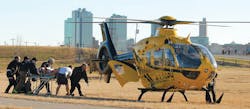Safety in and around helicopters has to start at a basic level with a briefing which is no different than what is given to passengers on a commercial airline.
An explanation of safety is the relative freedom from danger, risk, threat of harm, injury or loss to personnel and/or property, whether caused deliberately or by accident. Therefore the safety briefing has to be objective and not "from someone's point of view."
I'll break helicopter safety briefings down into two areas. The first one to being a passenger briefing and the later being a safety briefing for emergency workers who, from time to time, may be asked to assist in and around helicopter operations, being static or dynamic.
Passenger Briefings
Passengers should not only receive, but have the right to a safety briefing. Even though it seems benign to folks who fly regularly there is excitement and anxiousness in people who have rarely or never flown in a helicopter. Let's discuss what's included in a briefing for passengers flying in a helicopter, it does not matter whether it's an agency owned including military, contract or a private provider.
First and foremost is following the directions of the flight crew, it may be two pilots along with helicopter crew members or a single pilot operation.
Approach and departure should only happen with direction from a helicopter crew member or the pilot. No running around the aircraft and crouching to keep the head low when the blades are spinning.
there are many different kinds of seat belts and proper familiarization is crucial for proper effectiveness. Buckling them up when disembarking will prevent later damage. The seat belts should be left on at all times since helicopters fly lower and slower than commercial airliners and an unscheduled landing could come very quickly!
One of the first things to be compromised after an unscheduled landing will be the doors, so emergency exiting needs to be addressed. The windows and some doors will have an emergency release. Staying in the seat and not moving around during flight is also important. The center of gravity in flight is sensitive, even more so in smaller and lighter helicopters.
Stay away from the tail rotor. Aviation parts are very expensive and if you walk into a tail rotor while the helicopter is running it will be out of service, then again so will you. Leave doors closed, even though all articles within the cabin should be secure, Murphy's Law is always around the corner. If you have a two way radio leave it turned off, the cabin will be noisy and you won't be able to properly hear it. If there are no headsets or helmets furnished ear protection is strongly advised even if it's a few pieces of toilet paper jammed into ones ears, it may not look pretty but will help save your hearing in the long run. There is to be no smoking in and around helicopters and here's an interesting note. Over time some helicopters have come from the factory with ash trays and lighters installed! Jet fuel in basically the same consistency as diesel fuel. Aviation gas on the other hand is 100 octane low lead gasoline and will shake the neighborhood if the vapors are ignited, so 50 feet is a good minimum distance.
Responder Briefings
Now let's talk about the type of safety briefing emergency workers should have if called upon to assist in or around helicopters. In addition to covering the same items aforementioned there are additional areas of concern and importance.
Proper use of protective personal equipment (PPE) is crucial. If a fire helmet is worn around a spooled up helicopter it is imperative that the chin strap be secured and tight. The rotor wash will easily launch the helmet creating an injury or damage environment. Nomex clothing (sleeves down and collars up) with NFPA approved gloves and boots need to be worn.
Ear and eye protection is needed and while helmet visor shields stop the big stuff, the dust and smaller debris will get underneath. Goggles or snug fitting safety glasses are recommended. Disposable ear plugs are a quick fix for noise abatement.
Long handled tools are to be carried horizontal at the waist, equipment parallel to the ground and not on the shoulder. When the helicopter is running the main rotor system will look like a disk, positive movement through the outside area of the disk is strongly recommended, that is the area of greatest concern for blade movement that could ruin your day.
If helping with victims or patients, all personnel need to be on the same page in regards to loading - which side, head or feet, first - before nearing the aircraft. All articles need to be secured before entering the rotor wash area, such as blankets, towels and personal effects. Victims need to be secured properly so they don't arrive at the destination with more severe injuries than when they left the scene.
Hills and inclines present another issue when moving towards or away from a helicopter. When moving towards the helicopter one never wants to transition downhill and the opposite is true when moving away. Flat ground helps reduce safety concerns for the folks working around the aircraft. There are many other agency specifics that can be added, but I wanted to touch on general areas to think about when working around helicopters. Local helicopter providers, being government or private, that are used by your agency will provide first responder safety training.
- See Hank Reimer Live! Hank will be presenting "Knowing Your Aviation Resources: Limitations and Capabilities" at Firehouse Central in Las Vegas in Aug. 31, 2011.
HANK REIMER has spent the last 10 years assigned to the air operations section of the Los Angeles County Fire Department as a firefighter/paramedic and crew chief. Hank is part of the training cadre where helicopter technical rescue is a major part of the curriculum. He is a member of a federal incident management team and a qualified air operations branch director. Hank teaches inter-agency aviation courses and is a board member of the Helicopter Rescue and Response Association. Hank was a guest on The Buzz on Technical Rescue: L.A. County Air Operations podcast.
About the Author

Hank Reimer
For Firehouse.com
Hank Reimer has spent the last 10yrs assigned to the Air Operations Section of the Los Angeles County Fire Dept. as a firefighter/paramedic and crew chief. Hank is part of the training cadre, helicopter technical rescue is a major part of the curriculum. Hank also teaches Inter Agency aviation related courses, is a member of a Federal Incident Management Team and a qualified Air Operations Branch Director. Also a board member of the Helicopter Rescue & Response Association.
